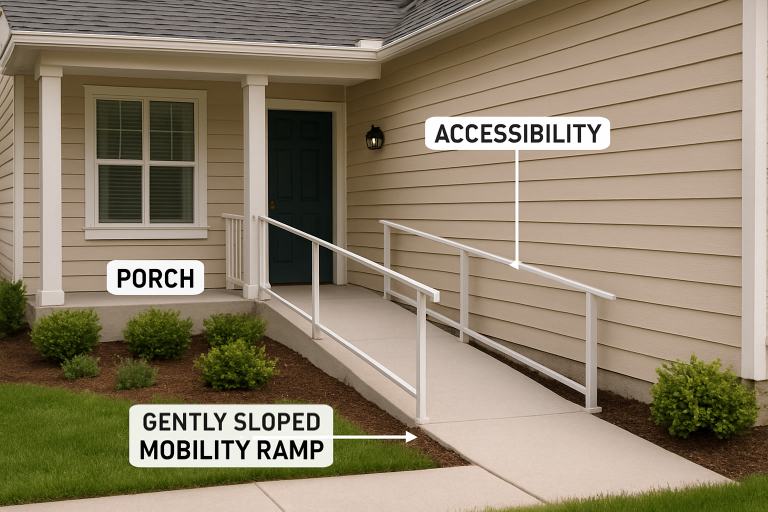Key Takeaways
- Mobility ramps enhance home accessibility for aging buyers and those with mobility challenges.
- Installing ramps can increase a property’s value and broaden its appeal.
- Design innovations allow ramps to blend seamlessly with home aesthetics.
- Investing in accessibility features offers both safety and financial benefits for homeowners and sellers.
Introduction
An increasing number of homebuyers are seeking spaces that support aging in place and address their evolving mobility needs. As a result, home staging now requires innovative strategies to ensure all properties are functional and inviting. Installing mobility ramps has become a widely recognized solution that ensures easy access without sacrificing curb appeal or value. These ramps are central in making modern homes safer, more practical, and more marketable to a broader spectrum of buyers.
Sellers and real estate professionals are finding that accessible home features attract aging buyers and increase interest from younger families planning for the long term. Emphasizing inclusive design in home staging—especially through thoughtfully integrated ramps—responds to the shifting demographics and preferences within today’s real estate market.
Understanding the Needs of Aging Buyers
Aging buyers often prioritize properties that allow them to enjoy independence and comfort as their abilities and routines change. Universal design features, such as step-free entries, wide hallways, and no-threshold shower stalls, are increasingly expected among this demographic. Mobility ramps are pivotal since they offer a safe, reliable entry point and help prevent falls, a significant concern for older adults.
Incorporating these features is about more than convenience; it’s about fostering confidence and peace of mind for the future. According to data from the National Association of Home Builders, features that support aging in place are becoming some of the most requested upgrades among buyers over 55.

Enhancing Accessibility with Mobility Ramps
Mobility ramps enable homeowners, visitors, and caregivers of all ages to move freely and safely. Unlike temporary solutions, permanent ramps add usability and value to a home. These ramps are specifically designed to remove barriers, making entryways and thresholds more accessible for everyone—whether they use wheelchairs or walkers or simply wish to minimize trip hazards. This straightforward change meets the requirements of buyers with mobility challenges and provides extended convenience to anyone with young children, groceries, or luggage in tow.
For homeowners in specific regions, such as Fredericksburg, tailored ramp solutions address environmental and property-specific factors, ensuring optimal usability. Specialized providers like mobility ramps Fredericksburg, VA can customize installation to harmonize durability, safety, and local needs. These accessibility enhancements show a commitment to thoughtful living environments that benefit aging buyers and multigenerational households.
Boosting Property Value and Market Appeal
Homes featuring accessibility modifications like ramps instantly broaden their buyer pool. Instead of limiting a home’s appeal to one generation, accessible properties are suitable for retirees, families planning for aging relatives, and even investors interested in rental properties. Properties designed with inclusivity are often perceived as higher quality and better maintained, resulting in faster sales and potentially higher closing prices.
As awareness of “universal design” grows nationwide, builders and sellers recognize that accessibility can drive demand and set homes apart in a competitive market. A home that demonstrates adaptability, safety, and future-readiness naturally stands out among buyers conducting thorough comparisons.
Design Considerations for Aesthetic Integration
Modern mobility ramps are engineered to offer both function and beauty. Gone are the days when ramps appeared sterile or industrial. Contemporary ramps are available in various materials—including aluminum, composite decking, stone, and wood-grain finishes—that blend with the home’s exterior. When carefully matched to the property’s style, the right ramp can complement landscaping and enhance curb appeal.
Safety Features Meet Stylish Solutions
Current advancements include slip-resistant surfaces, integrated handrails, subtle lighting, and seamless transitions to doorways and porches. These details improve safety and ensure that ramps integrate naturally, rather than detracting from a home’s overall appearance. Professional installation is essential to ensure both compliance and aesthetics, creating a seamless link between design intent and accessibility.
Financial Implications and Return on Investment
The initial cost of installing a mobility ramp varies based on material and complexity, but the long-term savings and benefits are compelling. For aging buyers or current homeowners, ramps significantly reduce the likelihood of falls, among the most common—and costly—risks associated with aging at home. Mitigating these risks can translate into substantial savings on healthcare and legal expenses. Additionally, a home outfitted for accessibility is more likely to retain and increase its value, yielding a strong return on investment when it comes to selling.
Many prospective buyers now view accessible upgrades, including ramps, as a forward-thinking choice, readying a home for future personal or familial needs and strengthening its long-term market position.
Final Thoughts
Mobility ramps are a practical, valuable addition when staging homes for an aging population. Incorporating these features signals that a property prioritizes comfort, dignity, and safety for all who enter. For sellers and real estate professionals, integrating ramps during home staging boosts property value and fulfills the growing demand for inclusive, future-proof living solutions. By embracing modern design, careful planning, and expert installation, homeowners can create welcoming environments that meet today’s and tomorrow’s needs.

